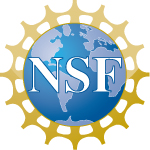NRAO Newsletter
Volume 18, Issue 1
31 January 2025
NRAO Newsletter
Volume 18, Issue 1 • 31 January 2025
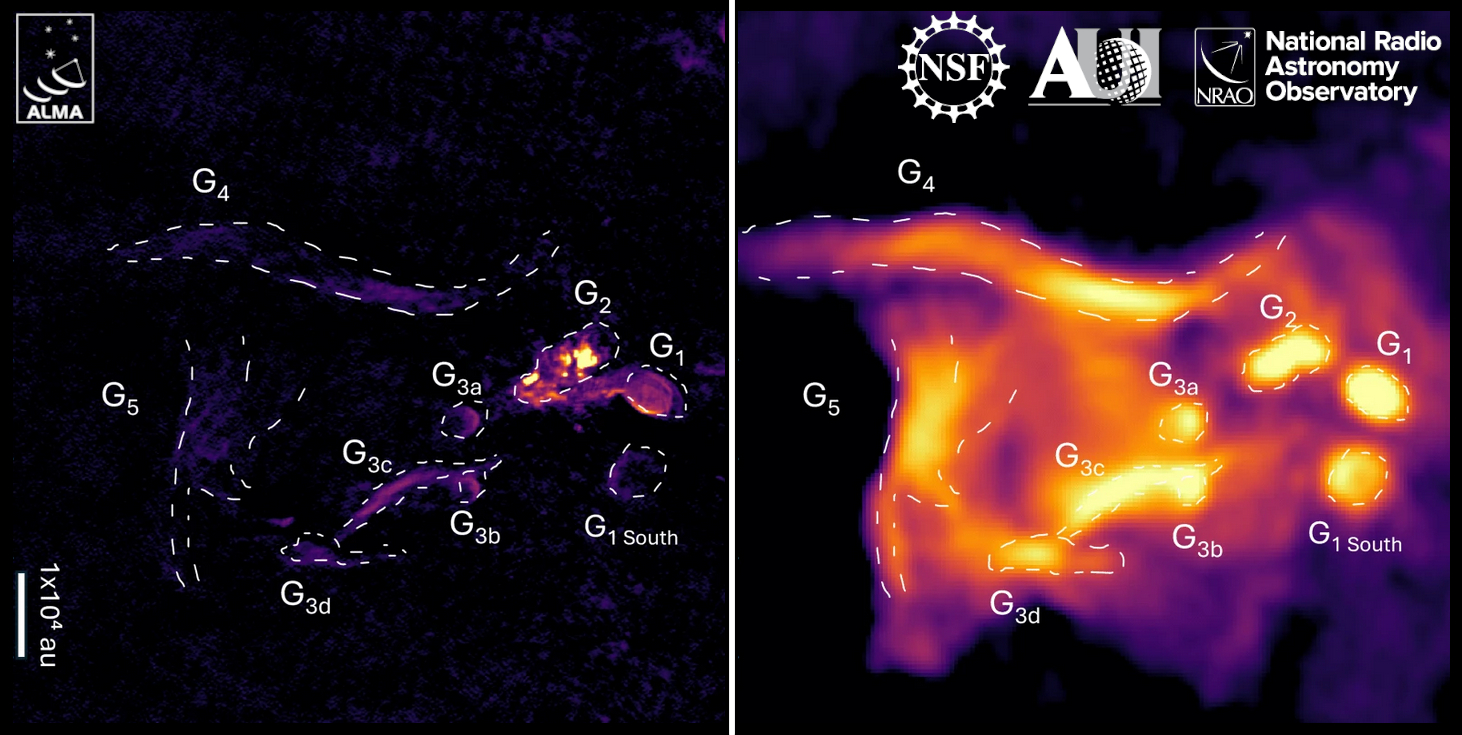 Observations of W49 from ALMA (left; 250 GHz) and NSF VLA (right; 9.1 GHz) presented by S. Cope, C. De Pree, and J. Tobin at the 245th meeting of the American Astronomical Society. W49 is a young star forming region 11.4 kiloparsecs from Earth and approximately 60 parsecs across. This study of gas and dust in the region makes W49A an ideal target to study newly formed massive O and B type stars and their environment.
Observations of W49 from ALMA (left; 250 GHz) and NSF VLA (right; 9.1 GHz) presented by S. Cope, C. De Pree, and J. Tobin at the 245th meeting of the American Astronomical Society. W49 is a young star forming region 11.4 kiloparsecs from Earth and approximately 60 parsecs across. This study of gas and dust in the region makes W49A an ideal target to study newly formed massive O and B type stars and their environment.
Upcoming Events

ALMA Data Reduction Party: Polarization
March 3-6, 2025 | Charlottesville, Virginia

Cosmic Horizons: AI-Powered Insights
May 6-8, 2025 | Austin, Texas

North America-Taiwan joint ALMA Science Workshop
June 16-20, 2025 | Taipei, Taiwan
NSF NRAO/GBO at the 245th Winter AAS at National Harbor
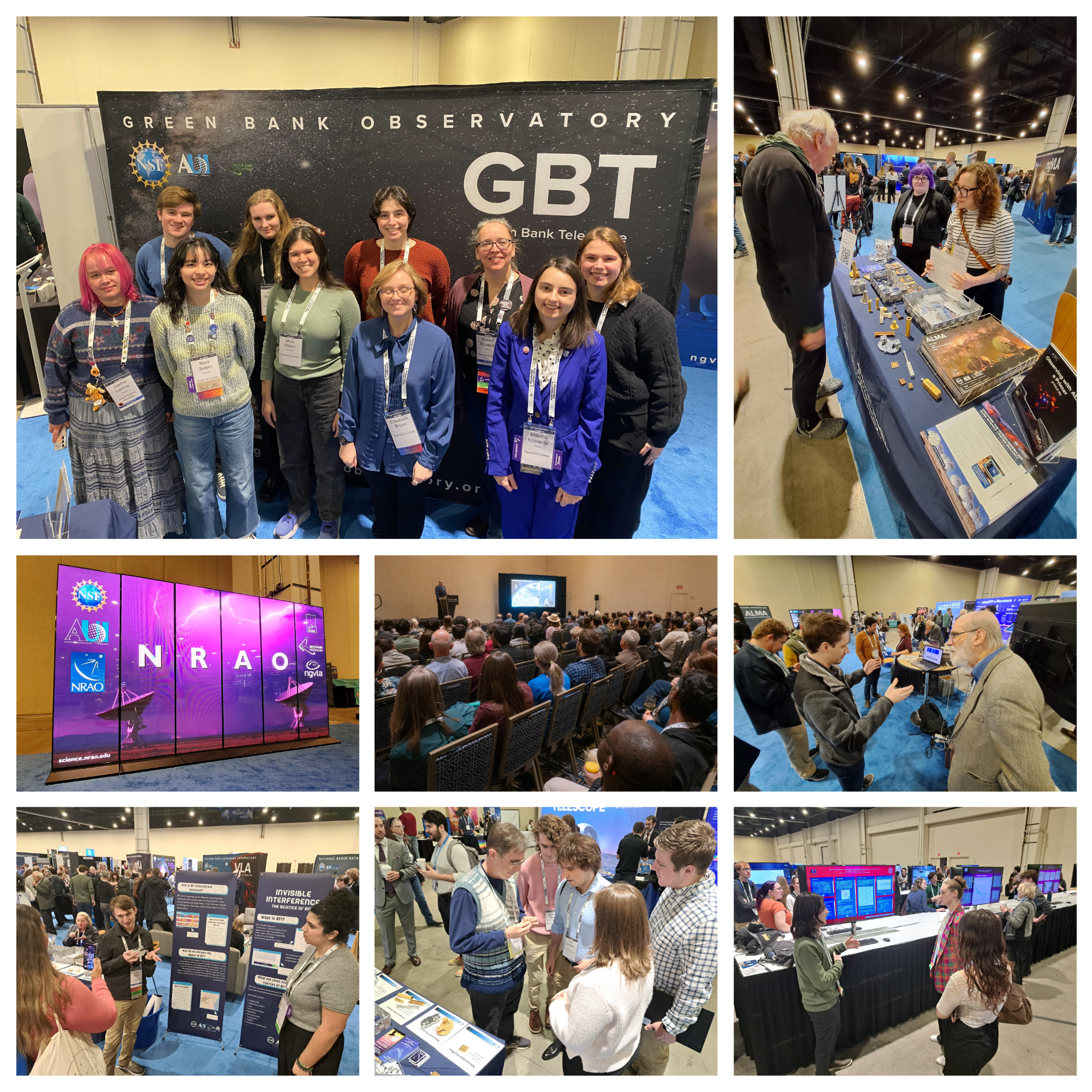
(Left to right; top to bottom): (1) Professor Karen Masters and students from Haverford College and Bryn Mawr tour the exhibit hall. (2) Jill Malusky and Jenn Snyder talk to conference attendees about meeting events. (3) The NSF NRAO Video Wall takes visitors through a tour of facilities and amazing science. (4) NSF NRAO Director Tony Beasley informs a packed room of AAS members about the latest from NSF NRAO. (5) David Bordenave shows a new antenna design. (6) Luke Datsko (University of Akron) talks about RFI detection. (7) Matt Morgan shows instrumentation to a group of students. (8) Emily Moravec listens to a student poster presentation. Browse the photo gallery.
The NSF NRAO and NSF GBO showcased the latest in science and radio astronomy development at the 245th meeting of the American Astronomical Society, January 12-16, 2025, at National Harbor, Maryland.
The Director's Office hosted an evening Town Hall event, informing the membership of new initiatives from The Observatory. The NSF NRAO and NSF GBO welcomed attendees in the exhibit hall, showcasing instrumentation from the Central Development Laboratory, updates on the ALMA Wideband Sensitivity Upgrade (WSU), and the exciting developments of the new ngVLA prototype antenna construction in New Mexico.
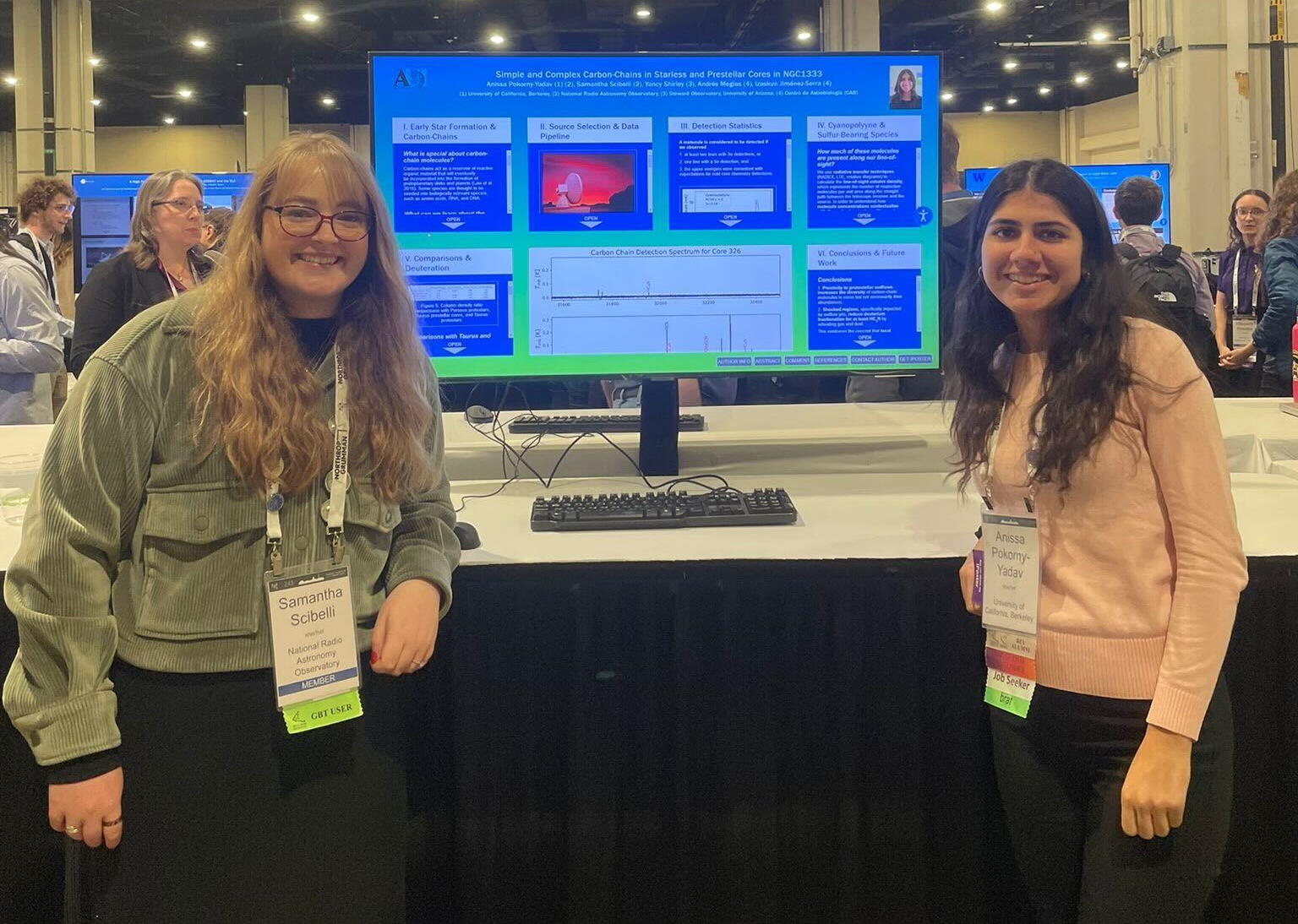
Science sessions on ngVLA, WSU, and over sixty outstanding student presentations covered a wide range of science and engineering topics - astrochemistry, molecular clouds, masers, pulsars, galaxies, and instrumentation.
A number of students were awarded prestigious Chambliss Awards from the AAS membership. These included NRAO students:
- Anissa Pokorny-Yadav (University of California, Berkeley, pictured above with advisor and NSF NRAO Jansky Fellow Samantha Scibelli)
- Nathan Shaw (Truman State University)
- Nora Salem (Haverford College)
- Kaitlyn Chen (NRDZ)
Over 3,700 attendees were able to get together to share the incredible science happening in our field. The NSF NRAO and NSF GBO thank the AAS Office and leadership for an outstanding conference.
Read the conference press releases.
Check out the photo gallery of NSF NRAO/GBO activities at the conference.
ngVLA Project News
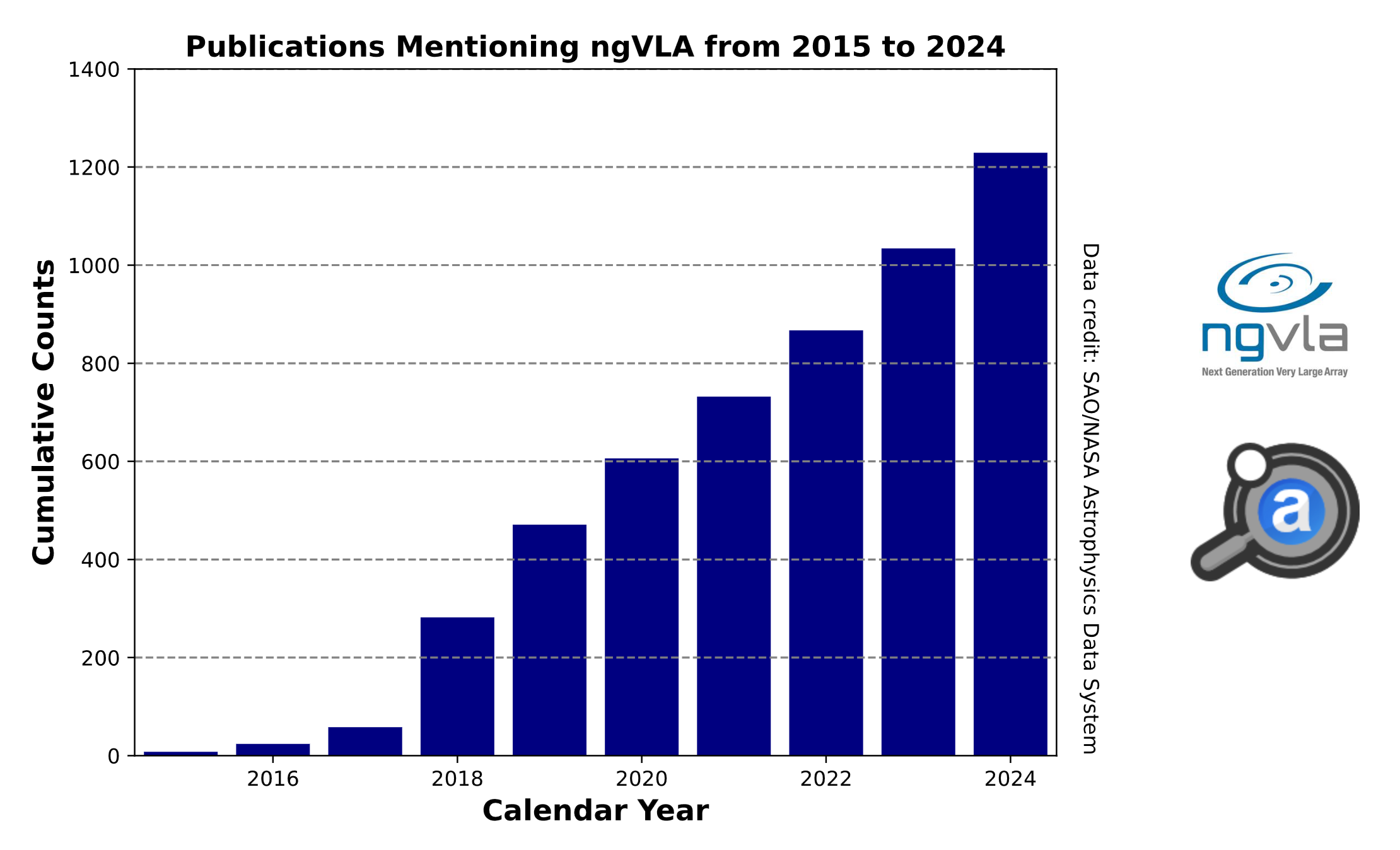
Publications Mentioning ngVLA Surpass 1220
The ngVLA was first discussed at a community workshop in 2015. During 2015-2024 the acronym ngVLA has appeared in 1229 publications indexed in the SAO/NASA Astrophysics Data System. This count features almost equal numbers of refereed and non-refereed publications. The metric is a testament to the community's unwavering enthusiasm for the ngVLA. A big thank you to all publication authors!
VLA+VLBA to ngVLA Transition Option Concepts
In 2022 an external and international committee, the Transition Advisory Group (TAG), was asked to make recommendations regarding option concepts for a VLA/VLBA to ngVLA transition. On 14 January 2025, the TAG posted its draft report and the TAG co-chairs announced the posting during Session 183 at the AAS 245 Winter meeting. Comments were sought from the 70+ session participants. The TAG is now collecting comments from the broader community until mid-April. Comments may be emailed to ngvla-transition-feedback@listmgr.nrao.edu. The TAG will consider all comments as it develops its final advisory report to NRAO, due later in the year. We thank the TAG, especially its co-chairs, Joseph Lazio (JPL) and Alessandra Corsi (JHU), for their efforts to identify transition option concepts.
Media from Science Conference in Mexico
The conference on "Follow the Monarchs: A Journey to Explore the Cosmos at (Sub)milliarcsecond Scales with the ngVLA" was held in November 2024 in person in Morelia, Mexico. The recorded talks and some pictures are now on-line.
ALMA Program News
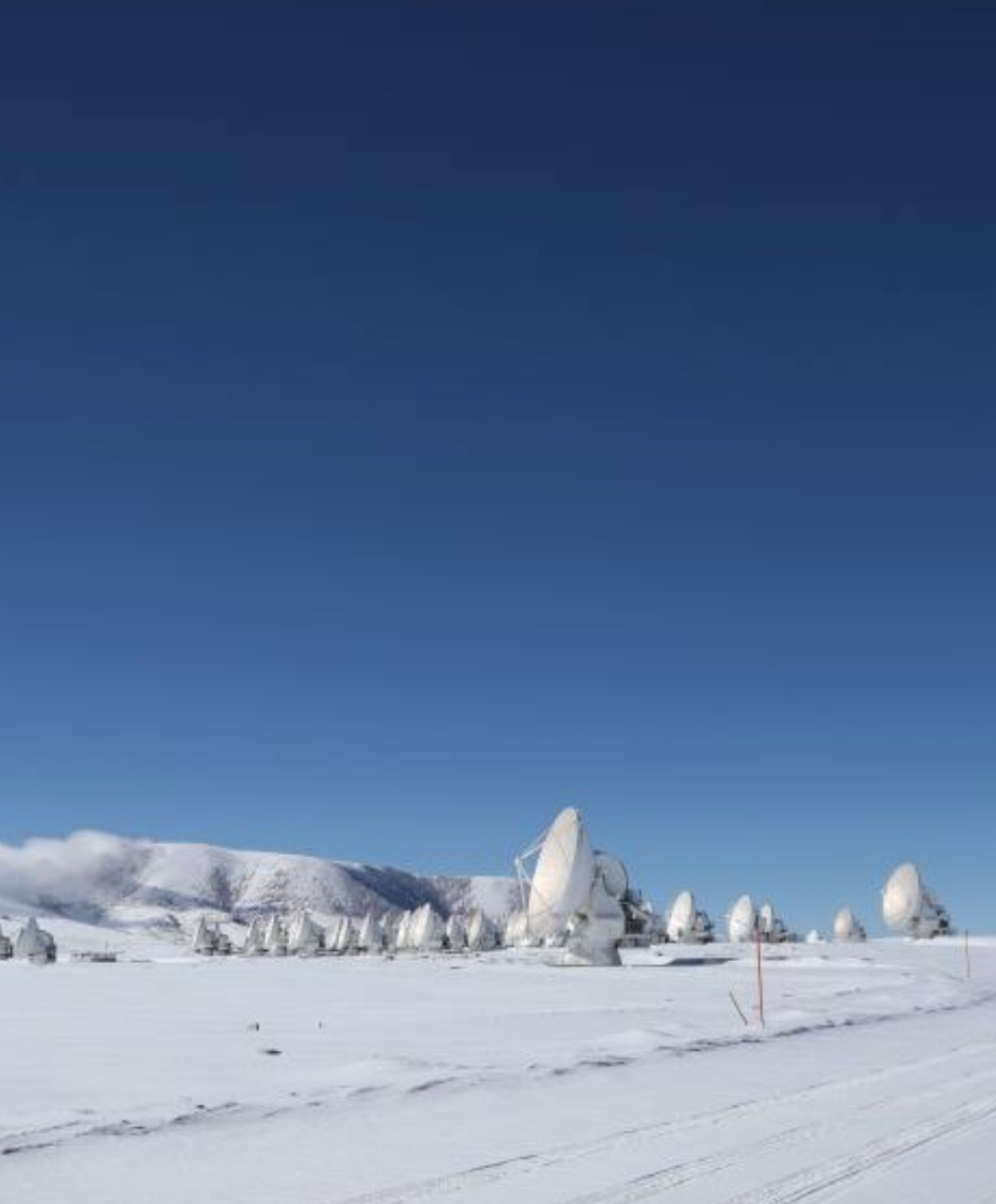
ALMA in summer encounters "Altiplanic Winter" when moisture moves over its 4000m site and snow falls. The photo at left shows one of two recent episodes. The array ceases observing during this time and enters an engineering period; this year from February 3 - March 1, 2025.
ALMA Status
The array is currently in configuration, C-4, with 780m maximum baselines nominally producing a 0.9" beam at 100GHz. The February engineering shutdown will begin on February 3rd at 09:00 am CLT. In Summer at its high altitude austral site, atmospheric water vapor increases (see photo) and observations are suspended for an engineering period. Observations should resume no later than 1 March in configuration C-4, until March 19th.
Announcement for ALMA Cycle 12
To assist users with early proposal planning for ALMA Cycle 12, the following key dates (anticipated) have been announced:
- 20 March 2025: Release of the ALMA Cycle 12 Call for Proposals and Observing Tool, and opening of the archive for proposal submission
- 24 April 2025: Proposal submission deadline
- October 2025: Start of Cycle 12 observations, spanning 12 months Other information on Cycle 12 is available on the ALMA portal. Full details will be published in the Cycle 12 Call for Proposals.<
ALMA at the 245th AAS, January 2025, National Harbor
At the 245th AAS meeting near Washington, DC, the NAASC hosted a well-attended special session 'New perspectives on protoplanetary disks in the era of JWST and the ALMA Wideband Sensitivity Upgrade' with four invited talks by M. Van't Hoff (Purdue University), C. Espaillat (Boston University), K. Pontoppidan (JPL), K. Zhang (Wisconsin) and a short general presentation of the Wideband Sensitivity Upgrade (WSU) by J. Meyer (NRAO).
ALMA Wideband Sensitivity Upgrade (WSU)
Preparations are under way for the WSU System Preliminary Design Review which will be held at NRAO / Charlottesville on July 7-9, 2025. The scope of this major review includes, amongst other topics, plans and strategy for assembly, integration, verification and commissioning (AIVC), plans for the transition towards WSU operations, and definition of requirements, specifications and interfaces.
OCRO Construction Project Kick-Off

The OSF Correlator Room (OCRO) detailed design and construction phase kicked off in early January with the award of the construction contract to the firm Symelec. As reported in the last eNews, the project was approved by the ALMA Board in November and was pending NSF contracts review, which was successfully completed.
OCRO is an essential project that will provide the physical infrastructure to support the new ALMA correlator (ATAC), the Total Power GPU Spectrometer (TPGS), the Data Transmission System (DTS) receiver, fiber optic patch panels, and other computing equipment. The room has power and HVAC capacity for the initial 2x bandwidth ATAC and for a future expansion to x4 bandwidth. The facility supports the infrastructure for direct contact liquid cooling and includes a new fire suppression system. OCRO will occupy the space previously used for the OSF Control Room, which is being moved across the corridor at the OSF.
The approved project is divided into two stages. The first is detailed design, which has now started and will conclude with a Critical Design and Manufacturing Readiness Review (CDMR) in late June 2025. Construction will commence soon after and is expected to complete in September 2026. The first construction task of installing electrical switch gear to connect the room to the ALMA power system has been completed and will be connected the first week of February.
Upcoming Meetings
Third North America-Taiwan joint ALMA Science Workshop
The third North America-Taiwan joint ALMA Science Workshop, will occur June 16-20, 2025 at ASIAA (Taipei). The event will feature a lineup of high-profile invited speakers; the contributed abstract submission deadline is February 7, 2025. The program, centered around new scientific opportunities from ALMA Band-1 and ALMA-WSU, will include ample opportunities for focused discussions. Note that NAASC travel support is available for US and Canada-affiliated early-career attendees (graduate students and post-docs).
Infrared Fine-Structure Lines Workshop
Abstract submission deadline is January 31, 2025, for the Infrared Fine-Structure Lines Workshop on all topics related to the use of the infrared fine-structure lines - which will take place at Winona State University in Winona, Minnesota, on June 10 - 13, 2025. Note that NAASC travel support is available for early-career attendees.
International Symposium on Molecular Spectroscopy (ISMS)
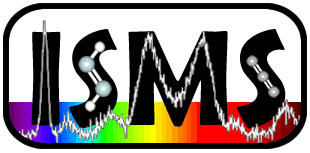
The ISMS is the leading annual conference in this dynamic and interdisciplinary field, bringing together experts for a unique blend of plenary talks from world-renowned leaders and parallel sessions featuring shorter presentations, many given by graduate students. The symposium fosters a highly collaborative and collegial environment, offering numerous opportunities for both formal and informal interactions. To encourage participation, registration and housing costs remain exceptionally low compared to similar conferences, making it possible for entire research groups to attend. In fact, many senior researchers in the field delivered their first-ever conference presentation at ISMS, benefiting from its welcoming and supportive audience.
Join us for the 78th ISMS, taking place June 23-27, 2025, in Urbana-Champaign, Illinois, and attend the ALMA/NGVLA-themed mini-symposium: "Astrochemistry - Laboratory, Computations, and Observations." Featured invited speakers include Roman Motiyenko (Université de Lille), Jenny Bergner (UC Berkeley), Jérôme Loreau (KU Leuven), Romane Le Gal (IRAP), Ilsa Cooke (University of British Columbia), Audrey Coutens (IRAP), and Xander Thelen (Caltech). Abstract submissions close on March 1, 2025 - don't miss this opportunity to be part of an engaging and cutting-edge scientific exchange!
GBT surveys of the 21-cm sky using ALPACA
Karen O'Neil (NRAO/GBO)
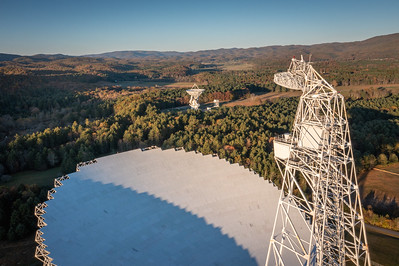
Photo by Jay Young, U.S. NSF/AUI/NSF GBO.
ALPACA, the Advanced L-band Phased Array Camera for Astronomy, is a phased-array receiver capable of providing high sensitivity observations simultaneously for 40 beams on the GBT in the 1-2 GHz band. ALPACA is one of the most advanced phased array feeds for wide-field imaging developed to date. It is the first such instrument to include a large number of array elements within a cryogenic dewar so that both the front end electronics and antenna elements are cooled. Installed as a receiver on the Green Bank Telescope, ALPACA will enable unprecedented survey capability for pulsar and radio burst detection, through probing the diffuse intergalactic gas leftover from the cosmic dawn, and mapping radio recombination lines, solar radio bursts, and the magnetic fields of the diffuse interstellar medium.
With the intention of maximizing the science return from this instrument, and advertising it to a diverse group of astronomers as possible, GBO invites members of the scientific community for a four-day workshop on April 25-28, 2025. In addition to outlining key science projects for ALPACA, it is intended that the workshop will allow potential users to learn about the instrument, form collaborations, and aid in the planning and commissioning of the instrument.
Further information and early registration for the meeting is available online.
GBT Observer Training Workshop
David Frayer (NRAO/GBO)

The next GBT Observer Training Workshop will be held in person at the Green Bank Observatory 18-20 March 2025. The workshop is designed to train GBT observers. Participants will learn the specifics of observing with the GBT and the basics of GBT data reduction. Registration is now open and applications will be accepted until January 31, 2025. Photo: Jay Young, U.S. NSF/AUI/NSF GBO.
Please visit the workshop website to learn more and fill out the application.
Arizona Radio Observatory 2025A Call for Proposals
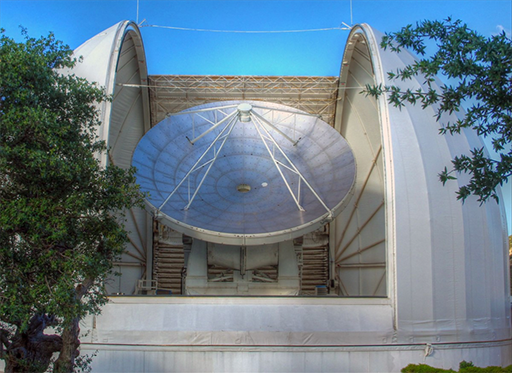
The University of Arizona's Steward Observatory solicits proposals for Arizona Radio Observatory (ARO) telescopes for observing during semester 25A (Feb - Jun, 2025) for:
(1) The 10-m UA ARO Submillimeter Telescope (SMT), located on Mount Graham, Arizona. Proposals are invited from the general astronomical community for observations with the 1.3 (ALMA Band 6) and 0.8 (ALMA Band 7) mm receivers and the standard backend, which offers bandwidths of 32 to 2000 MHz and channel resolutions from 0.25 to 1 MHz. In parallel with the current backend, a new backend with resolutions of 15.6 kHz to 1 MHz is available on a shared-risk basis.
(2) The UA ARO 12-meter Telescope (12M), located on Kitt Peak, Arizona. Proposals are invited from the general astronomical community for observations with the 4-band receiver covering the 4, 3 (ALMA Band 3), 2, and 1 (ALMA Band 6) mm bands and the AROWS backend with bandwidths of 20 to 4000 MHz and channel spacings from 9.8 to 625 kHz.
In case of oversubscription, preference will be given to Arizona (UA, ASU, and NAU) and student thesis proposals. Proposers are requested to fill out both pages of the cover sheet, science justification (two pages), technical justification (two pages), and past allocation update (one page).
View the ARO Call for Proposals for complete instructions. The deadline for proposals is 23:59 MST on February 7, 2025.
Ohio State Astronomy Professor Awarded Henry Draper Medal
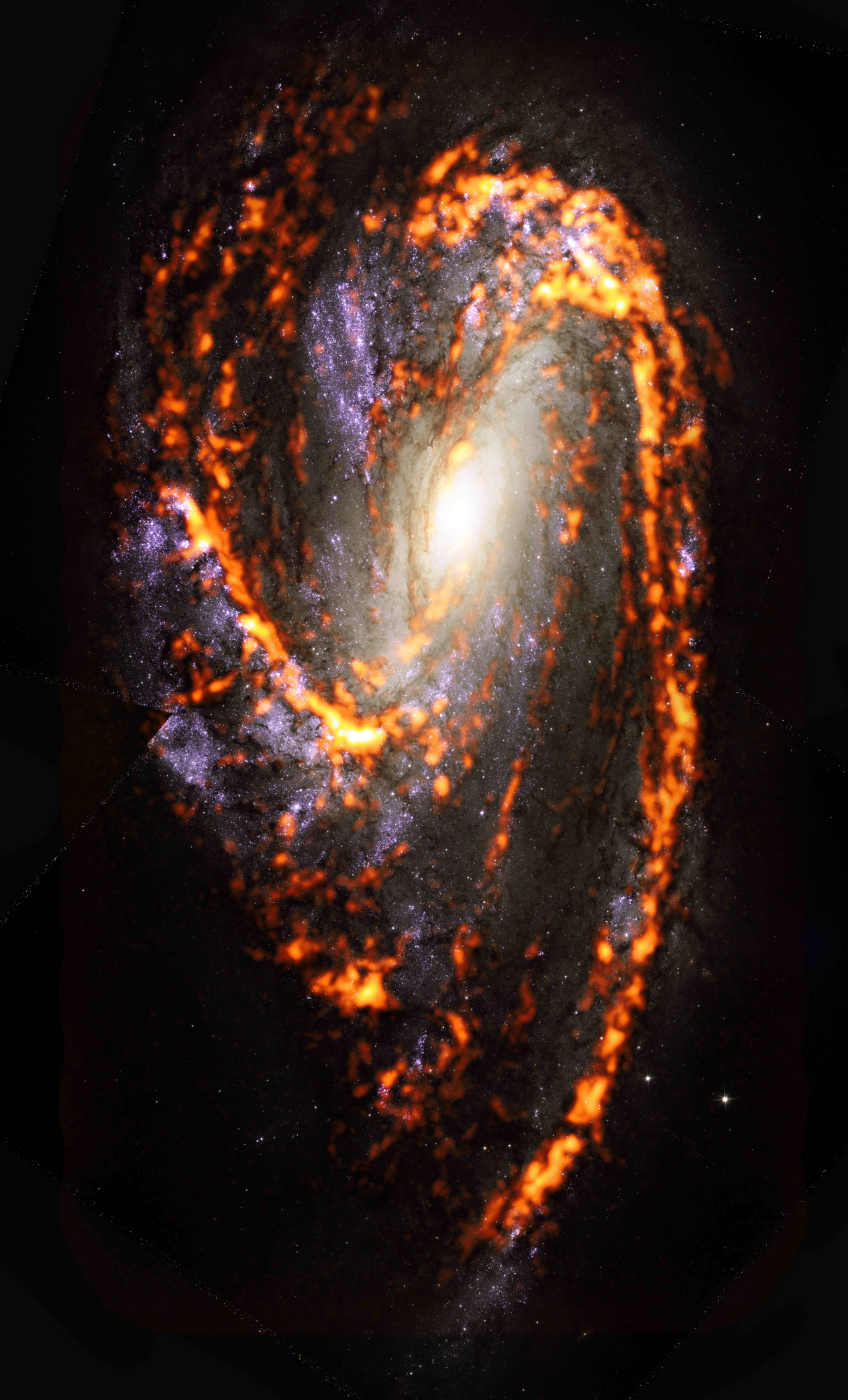
Adam Leroy, a professor of astronomy at The Ohio State University, has been named the recipient of the 2025 Henry Draper Medal. His work was selected for pathbreaking efforts that have characterized, "in unprecedented detail, the physical nature of the interstellar medium and its relationship to star formation in nearby galaxies." The work has made use of many telescopes, including ALMA, with the PHANGS project.
The oldest medal awarded by the National Academy of Sciences, the Henry Draper Medal celebrates those who have made "a recent, original investigation in astronomical physics, of sufficient importance and benefit to science to merit such recognition."" It is awarded every four years.
Read more about the award.
Image: NGC 3627 from PHANGS-ALMA. Credit: ALMA (ESO/NAOJ/NSF NRAO)/ESA/NASA/PHANGS, S. Dagnello (NSF NRAO).
Recent Science Media Releases
|
NSF VLA Contributes Crucial Puzzle Piece to 'Peculiar' High Energy Transient
|
|
|
Double the Disks, Double the Discovery: New Insights into Planet Formation in DF Tau
|
|
|
Young Stars in the Milky Way's Backyard Challenge Our Understanding of How They Form
|
|
|
Astronomers Catch Unprecedented Features at Brink of Active Black Hole
|
|
|
A Stellar Farewell: Dr. James Jackson Retires as Director of NSF Green Bank Observatory
|
|
|
Helical Magnetic Fields: A Universal Mechanism for Jet Collimation?
|
|
|
Contact the NRAO press office to share your new and exciting science results. |
From the Archives
Ellen Bouton

About this month's photo: Through the spring and summer of 1967, the first successful interferometric observations with widely spaced antennas were made between NRAO's 85 Foot Tatel telescope and NRL's Maryland Point 85 foot, between the Algonquin Park 150 foot and the Penticton 25 meter, and using the MIT/Haystack 120 foot, the NRAO 140 foot, and the Hat Creek 85 foot. Olaf Rydbeck, Sweden's Onsala Observatory Director, wanted to get into VLBI, and his connection with Hein Hvatum, Rydbeck's former student who was at NRAO, led to plans for an NRAO-Onsala experiment. Another of Rydbeck's students, Erick Kolberg, became the world's expert in building maser amplifiers for radio astronomy, and his sensitive receivers using traveling wave masers were one of the attractions of using Onsala for VLBI. Recorders and clocks were shipped from Green Bank to Onsala, and the first international VLBI observations on 27 January-3 February 1968, at both 6 and 18 cm with a baseline of 6319 km, showed that some quasars and AGN were smaller than one thousandth of an arcsec. This was the highest angular resolution ever obtained for any astronomical observation; results were reported in ApJ. Within a year interferometer baselines had increased to intercontinental distances and the angular resolution to better than one thousandth of an arcsec.
The 1971 Rumford Prize was awarded jointly to the NRAO-Cornell, MIT-Haystack, and Canadian VLBI teams for their development of long-baseline interferometry.
The photo is a composite showing the NRAO 140 Foot, with Barry Clark, who developed most of the technology for the VLBI observations and headed up the observations in Green Bank, and the Onsala 85 foot, with Olaf Rydbeck and Ken Kellermann; Ken and Claude Bare traveled from NRAO to Onsala for the observations.
From the Archives is an ongoing series illustrating NRAO and U.S. radio astronomy history via images selected from our collections of individuals' and institutional papers. If readers have images they believe would be of interest to the Archives, please contact Ellen Bouton.

